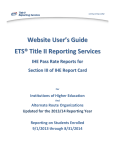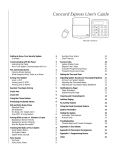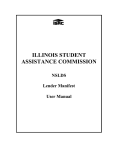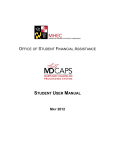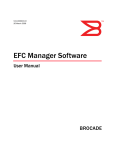Download Elise Miller: Again, good afternoon. I`m Elise Miller and I am part of
Transcript
VAE_FSA_24 Elise Miller, Male 1, Male 2, Male 3, Female, Male 4, Male 5, Male 6 Elise Miller: Page 1 of 20 Again, good afternoon. I'm Elise Miller and I am part of what is the National Center for Education Statistics. Now that's part of the Department of Education, so I know you deal mostly with federal student aid, which is another part, but we are, um, the NCS portion and you might know me as the IPEDS person, so – I am the program director – oh, I heard that. (Laughter) Yeah. That's me. Uh, I'm that evil one. Um, I am program director for IPEDS, which means I oversee that data collection and I know that every year you get these forms and you get very frustrated with me. So I encourage you to go to the other session that we have set up here where our, uh, survey director for IPEDS will be here giving details on submitting the data, 'cause I know it was a bear last year. There's a lot of changes so that we could get some net price information. And, um, Archie's gonna do a great job explaining all that to you. Um, again, I, uh – I hope you all got something to eat. I waited in a – a line for half an hour – or for, like, an hour and at 1:15 realized there was no way I was gonna eat, so I ran back over here and I look like I've been at the gym, but I have not. So I'm sorry about – if I look sweaty. Um, but thank goodness we're here in Orlando where it's so beautiful. All right. Let's get under way. Um, first of all, how many of you – did any of you attend the session last year that I did in Nashville? Okay, great. Um, I don’t know if there's new information here – I think there is new information. In addition, we've just been able to refine some of the information so we can communicate it better. So I'm glad you're back this year. Quickly on the agenda we're gonna give background, we're gonna present what the Department of Education and specifically, um, we at NCS developed as a calculator that you can use if you don’t wanna develop your own. We're gonna talk about – give you some ideas of things you should be thinking about. The requirement is coming closer this year, it's October 2011 when you're gonna need to have these on your websites. So last year we had some breathing room, but it's – you know, it's less than a year now. We'll talk about some resources that are out there and already available to you. And then briefly just touch on some of the frequently asked questions that we've gotten, um, since we, uh, released the – well, actually since HEOA was passed with this requirement in it. And just so you know, um, last year I tried to gather people's business cards with questions on them that I could get back to later and answer and that proved to be a bear. So, um, I encourage you to e-mail me any questions that we don't get www.verbalink.com Page 1 of 20 VAE_FSA_24 Elise Miller, Male 1, Male 2, Male 3, Female, Male 4, Male 5, Male 6 Page 2 of 20 answered today and that way we can update the frequently asked questions and share that information not just with this crowd, but with all the eight administrators out there who are interested in that information. So you're very familiar with HEOA, I'm sure. Higher Education Opportunity Act signed into law in 2008. Um, it includes – includes many disclosure requirements, um, and that's what we consider the net price calculator requirement. And we distinguish a disclosure requirement as something that you need to disclose to students or some other parties on your campus, from a reporting requirement, which is IPEDS, something that you actually have to report to us at the department. Okay. So this is something that you need to have on your websites to disclose to students information about net price. Now, um, I do wanna highlight here that the law defines net price as being the price, uh, after grant aid for first time, full-time students, so if you have no first time, full-time students you can leave the room now. No. (Laughter) Um, but seriously, that's a question that's come up a lot. It does define it for first time, fulltime students so you're not required to do it if you don’t have those students, but that doesn’t stop you from doing it either. So as I mentioned earlier the deadline is fast approaching, because you have two years from when we released our template to actually get a calculator live on your website. We, uh, were able to get a template out there on October 29, 2009. Um, you can access it both through the IPEDS website and also through, um, the OPE website where there's HEOA updates. But here's the thing, you do not have to use the department's version and so if you don’t like it I understand. We'll talk a bit more about why it is the way it is and how you might wanna change it. But, um, you also have the option of developing your own calculator or starting with our calculator and maybe doing a modified version that best suits your campus. So just to give you a little of the background that came out of the actual legislation and the purpose is to help current and perspective students, families, and other consumers estimate the individual net price of the institution of higher education. So as you know from filling out IPEDS last year we're also calculating a few net prices to be put on the college navigator website, but those are really, really, um, at a high level and not very detailed and might not tell a student based on who they are what they would be likely to pay. Now the purpose here is to give a more individualized net price www.verbalink.com Page 2 of 20 VAE_FSA_24 Elise Miller, Male 1, Male 2, Male 3, Female, Male 4, Male 5, Male 6 Page 3 of 20 than one would get off the college navigator, which is where we display data that's reported to IPEDS. That being said, we know that it's a very difficult thing to do to give a precise estimate to a student of what they should pay. So one thing we really, really wanna do is get beyond sticker price, because so often it is still the sticker price that folks focus on as what they would have to pay to go to a college. So this is really the first time we're saying really push out there what they're gonna be paying after grant aid so they understand that the sticker price is not necessarily what, um, will be coming out of their pockets. Just a quick overview of how the law itself defines net price. Again, it's for first time, full-time students. That doesn’t mean you can't add features to an individualized calculator if you customize it on your campus to do it for other types of students, as well. But at a minimum you need to calculate it for first time, full-time students if you enroll them. And basically, um, we're gonna change the language in our template. We've been calling it price of attendance – that's what we call it on IPEDS so we were trying to be consistent, but we understand that cost of attendance, um, resonates with more people in financial aid world, so we are gonna switch up that language. So it's really cost of attendance minus, um, both merit and need based grant aid, and it's – the median amount that is awarded to the students. So we didn’t just develop this on our own, we actually enlisted a lot of experts from the higher ED community. What we have really seen is that this, um, new effort with the net price calculator takes a collaboration of institutional research offices and financial aid offices and so we've been trying to come to audiences such as yourself. We go to the institutional researchers meetings, as well, and we talk to them about how they might need to work together to meet the requirement. We also brought them all around the table to actually figure out how we might be able to do this. The goal at that meeting in January 2009 was to keep it simple. As you know there's over 6800 title 4 institutions – 6800 different schools out there and as you know – I bet if you look to the left and the right of you, you'll find someone sitting next to an institution that might seem similar on the surface, but is actually very different from you. And trying to come up with a single template that works for every type of institution is difficult. So we really tried to keep it simple. www.verbalink.com Page 3 of 20 VAE_FSA_24 Elise Miller, Male 1, Male 2, Male 3, Female, Male 4, Male 5, Male 6 Page 4 of 20 For instance nothing in this, um, collects information that might be used to determine merit aid at your institution, partly because we don’t know what you use to determine merit aid at your institution. Um, some institutions might use GPA others might use other factors and if we built an element in that says you have to collect high school GPA then every institution would have to use that in their calculator, regardless of whether or not they consider it in awarding aid. So we really tried to keep it at the very basic level knowing that you would have an interest in making it more precise as, um – as you are able. So I just wanna emphasize one thing – I mean, we have to do – this has to work for a cosmetology college as well as a research university and everything in between. So you can see the complexity of having to develop something that might work for all those different types of institutions. So if you haven’t checked out the template yet, I encourage you to do it. I was really excited how we were able to make this work. Basically you can access it, again, through the IPEDS website and you go in and there's a user manual that you'll be able to print out to help you, but you're gonna use an institutional application to prepare the calculator, then it actually produces something that you're IT person can put on your website very easily. It's basically about picking a URL name and dragging and dropping files to create it. I'm not a tech person, but I've seen someone do it, so it's really easy, um, if you decide to use the template. So just a quick overview of the institutional information. Now this is not the easy part, this is having to gather data to put into the institutional application so that we can produce the calculator. So price or cost of attendance data – that gets reported to IPEDS, as well. You probably don’t get that form, because it's not on the financial aid form. In IPEDS it's on something called the institutional characteristics form, but it should put – be the – that same number that your IR office is reporting to IPEDS. It's first time, full-time students, price of attendance or you call it cost of attendance. Then, um, users are asked 9 questions – 9 simple questions on their dependency status, um, cost of attendance, and EFC when the students go to use the tool they're asked these questions and that's what we use to output a net price. So a little bit of behind the scenes. So how does that all work? That's seems pretty simple for something that's really complex. Well the technical review panel that got together – the financial aid administrators and the IR officers that got together to talk about this decided that the best approach, because it's so hard to predict forward what you're gonna be able to give out in financial aid, www.verbalink.com Page 4 of 20 VAE_FSA_24 Elise Miller, Male 1, Male 2, Male 3, Female, Male 4, Male 5, Male 6 Page 5 of 20 would be to develop this template, at least, as something that says, what would a student who is similar to me have gotten last year? What would my net price have been a previous year? And so what we have is a lookup table. It's data in the background where you find the characteristics of the students based on what they entered, you find the EFC range based on some data that the department provides, and then it looks up the median grant amount that you as the institutional person entered into our application, and it subtracts cost of attendance minus that median grant amount. We'll see some more to make sense of that. So again, if you want to write down the website, but if you easily go to – search for IPEDS on Google you'll be able to click right there, go to IPEDS and it's under resources. Very easy to find. Again, I encourage you to start out by printing out that PDF – that help menu. Some of the questions that'll come up for you will be in there. We've tried to include screenshots in there so you can see what you will be facing as you walk through the application. We're gonna add some features along the way, as well. Um, we should be launching a new version of this and it doesn’t change the basics in it, it just makes it easier to use and updates the data. So step one once you get into the application is to decide what year. Now – we are, um, waiting now to do 2009-10; I just got the data file this morning so hopefully we will be able to release the template with that data, um, within the next few weeks. I promise it before the end of the calendar year. So they'll have 2008-09 and 09-10. We've also had a lot of requests for the data tables we used behind the scenes related to EFC, which I'll show you a preview of later. We'll be releasing all that information so you'll have all that at your disposal, which will help if you decide to customize it and give, um – customize what we do, maybe you just wanna make a few adjustments. Um, it'll give – it'll be very transparent and easy to do that way. The other question we ask is whether you’re an academic or a program reporter. Does any in the – anyone in the room, um, think that they are a – know that they are a program reporter? Okay. Good. So let me just explain the concept briefly since we have a few in. Basically, um, some institutions charge completely by the program. So when we collect data for instance in IPEDS instead of saying what's your academic year tuition perhaps it's a four month program and they charge just a price for that four month program. So there's really nothing – the concept of academic year is foreign to that type of school. www.verbalink.com Page 5 of 20 VAE_FSA_24 Elise Miller, Male 1, Male 2, Male 3, Female, Male 4, Male 5, Male 6 Page 6 of 20 So what we do in IPEDS since they have multiple programs that might have multiple prices – you might have a, you know, 4 month program, you might have an 18 month program. Um, we collect information on their six largest programs, but for the purpose of this, um, calculator we have, um, done it for the largest program. So that largest program your school reports to IPEDS if you're a program reporter, will also be what will be – you'll be using in this, um, net price calculator. So now we don’t want you to have to enter data that isn't relevant to your institution. We wanna customize our application as much as possible, too. So there are a few screening questions here to limit the number of cells you will see in the tables to follow. So we ask about whether you have on campus housing. If you don’t, then you shouldn’t need to enter information on that, uh, price, uh, or cost of attendance. We also ask – following that if you have on campus housing, well do all students – are they all first time, fulltime students living on campus, then you don’t need to answer questions about off campus living. Um, then also we ask about in state, out of state, in district, you know, you don’t wanna have to answer if you're a private institution, you don’t have in state, out of state different prices so therefore you wouldn’t have to enter different information for those. So after we get an idea of what kind of data is relevant to your institution, we produce tables for you to actually input the data. And this will take some time; it's not gonna – because you have to look some of it up. The cost of attendance is fairly basic, it's information that's pretty readily available, again, it's already reported to IPEDS. It's basically just your in state, out of state, tuition, fees, book supplies, room and board, other, based on the student budget and as reported to IPEDS. Now the sorta new and different thing is this – these median grant amounts. So I'm sorry this is small, um, but there are about – let's see – 12 ranges over there on the left side – hand side of EFC ranges. First is zero – EFC being at the bottom and then at the – or at the top and at the very bottom is actually non-FAFSA filers, because, um, we want – not everyone files a FAFSA, they could still use this. We would assume in our template that they wouldn’t get aid since ours is based on basically EFC, which you wouldn’t know. And there's ranges all between. So then you have a number of boxes that align with the boxes you had in your tuition and cost of attendance table. So you would calculate – for instance, the EFC – the median EFC – I'm sorry the median grant amount for www.verbalink.com Page 6 of 20 VAE_FSA_24 Elise Miller, Male 1, Male 2, Male 3, Female, Male 4, Male 5, Male 6 Page 7 of 20 someone who had a zero EFC who lived on campus and was from in state. That's box number one. Okay. So this will take some time. Now we also wanted to give you the opportunity – 'cause we heard a lot from the community of concerns that this data might be misinterpreted, that students might walk in and say, okay, this is what I'm gonna pay. Um, we know that that is not the case and we wanted to do whatever we could to accommodate those concerns. There are a set of explanations and caveats that the law required we put in there and I think they're good. They say things like the department – the secretary of education, FSA, the state, the institution, are not promising you this, you know, net price. This is just giving you some idea. So there's a general amount of caveats that will be included in the output regardless. However, we also wanted to give you an opportunity to personalize it and customize it for your institution. So we have provided three different explanation boxes in which you can provide some additional sort of footnotes and caveats that would be displayed with the output on the calculator. So for instance, perhaps, um – perhaps it doesn’t make sense to include the international students in these calculations. Well you could say down here, does not include international students. Okay. Another example might be, um – let's say your engineering program pays a higher cost of attendance than the most first time, full-time programs or something like that, so this – the cost of attendance you entered wouldn’t be applicable to engineering students. You'd wanna make a note of that, as well. We do allow you to review all that information that you entered. So a quick review of the information to make sure you still agree with it. And then, ba-boom. I don’t know the right word. (Laughter) Um, out comes a file – multiple files including images and everything you need to do – to put that on your website ready to use. Okay. So it basically – last year we demo 'd doing it, but it took a little time to do it in front of you, but, um, it's – it's really quite simple. Just – you just create the URL so if ___ institution backslash, you know, net price calculator or whatever you decide to call it, and you drag and drop files on to that, um, space and then it's there. So the data files are there, the images are there. You can also go into the code and add your institution name and things like that or additional text. So it's, uh, fairly easy to do. Now – so what is there? Well this is what it looks like for a student or a parent who's coming in to use this if you decide to use www.verbalink.com Page 7 of 20 VAE_FSA_24 Elise Miller, Male 1, Male 2, Male 3, Female, Male 4, Male 5, Male 6 Page 8 of 20 this template on your website. First of all we decided to take that caveat up front and have them agree to it before they even get in to the calculator. So, you know, I can't guarantee they will read it, but it does say here that this is not a commitment of what you will be paying to attend this institution. Um, and it encourages them to go to FAFSA to fill out, um – and to actually apply for financial aid. So they agree to that and that's the first step of the end users process. So here's the questions they're asked. And I just wanna emphasize again, the reason we wanted to keep it limited to these very few questions is because it has to work across all different types of institutions, but also we didn’t want to intimidate or scare off, uh, students who are using it. So we tried to keep it to a – the minimum amount possible. Institutions have the option to add additional questions that will give more precise estimates at their institutions. But this is the set, um, that we are using to do an approximated EFC, as well as sort of an estimated dependency status. You know that there are a lot of factors that can go in to dependency status and you – if you put that in front of a student they'd probably get confused really quickly and it might – they might not finish using the application. So we really limited it to just some bare minimum questions that still gets us to a place where we can approximate these things. First question. Are you gonna apply for financial aid? If no, well then they go into that non FAFSA file or category and they don’t really need to figure out the rest of the questions. Next question. Age? That age is simply being used to try to figure out their dependency. Now we could say are you dependent or independent? But the information we have gotten back is often students don’t know. So we took in some characteristics that would help us determine that, because sometimes that language just doesn’t make sense to them. So if they're 24 or older they are just automatic – we put them in the independent category. Next we ask if they plan to live on campus or off campus or off campus with family so that we can determine the correct cost of attendance to use in doing the calculations. We also ask, um, whether they will be pay – plan to be paying – if they're eligible for in state or out of state tuition, if that was something you included when you did your part of the calculator. If you didn’t say we offer in state versus out of state it won't say that. So it is customized for your institution to that extent. Marital www.verbalink.com Page 8 of 20 VAE_FSA_24 Elise Miller, Male 1, Male 2, Male 3, Female, Male 4, Male 5, Male 6 Page 9 of 20 status, again, is something that we're using to help approximate – I have a typo there, sorry – uh, what there dependency status is. So if they say they're married, we're gonna put them in the independent category. If they say they have children – dependent children then, again, we're gonna put them in the independent with children category. And that – all those factors are used then to look up an EFC for the students. Um, the – the data tables is also broken down by the number of people in the household. So now we know – we figured out a dependency, now we're crossing that with the number of people in the household and the number of people in college next year. So we have a data table that takes into consideration dependency status, number in college, and number in family, and then parent – then income – parent institute and income if it's a dependent. Okay. And then it goes and finds the cell in our data table behind the scenes, which is based on FAFSA data from FAFSA filers that says students who are – let's say dependent with four people in their family, one in college, and this income range their median EFC was this. Okay. And that's what's in our look up table in the background. And we have a cell crossing all those different characteristics. Like in the institutional application, the student application, um, also has a review screen, so they can look at the information that they entered. If they decide to change some of that information they can go back and change it. Otherwise they can continue on to the final result. This is just an example of what that data looks like and again we will be releasing this data file so that you can actually see the data behind the scene, but it basically just shows the median EFC, four people by dependency status, number in college, family size, income level. So this is what the output screen looks like. Again, I'm sorry that the writing small, it's a lot to fit on a slide, but, um, it shows the academic year on which it's based. It breaks out the price of attendance – cost of attendance by tuition and fees, room and board, all those fields that you entered, uh, when you did the, uh, institutional part. Then the estimated total grant aid and then it just subtracts that grant aid from the top line, cost of attendance, and gives an estimated net price. In the bottom in red with some bold is saying this is not a guarantee of what you're paying, this just gives you an idea of what students with similar characteristics to yours paid, um, in previous years. And then any additional caveats that you entered that are specific to your institution also would appear underneath that. www.verbalink.com Page 9 of 20 VAE_FSA_24 Elise Miller, Male 1, Male 2, Male 3, Female, Male 4, Male 5, Male 6 Page 10 of 20 So if you talk to your IT folks or if you’re an IT folk yourself, maybe this will make lots of sense to you, but this is actually what is produced, an HTML file. We wanted to use something that went across platforms that everyone would be able to use – whatever systems they're using on their campuses. And some of the other features we've already covered, but this is just a summary, like, it works for academic year reporters, it works for program year reporters. It uses this look up table approach rather than a predictive EFC formula approach, uh, to doing this. All right. Another question that's come up is, the law says average, you're saying median, what's the deal? Well we piloted this with a number of institutions. We had some IR people and we had some financial aid people test out the calculator when we – when it was under development and they ran it and did it with their averages and they realized that the numbers were getting very skewed, um, by some applicants in certain categories. For instance, maybe an athlete was – got a very large award and it was skewing the numbers. And so, um, we had conversations with NASFA, as well as AIR, which is the Association for Institutional Researchers and we had some internal conversations and decided that median really is a better measure of central tendency in this case than an average would be, which could get skewed and really throw off the information and be misleading. So now – now we have what, about, um – we have about 10 months for you to get this up on your website. So we wanna give you some questions today to think about as you decide where to go from here. First of all, do you just wanna use the department template? By the end of the calendar year I've promised to have an updated version up there, so you could go home in January and do this and enter the data and have something up even before October, but it will need to be updated as new versions of our data are released to you. Um, the other option, as the law says, is you can develop your own calculator. And the only requirement is that it contains the same minimum set of elements as the department, which I'll cover in a second. Um, but in developing your own there's a lot of third party vendors out there, I'm sure you've been contacted by many of them and they have been, um, coming up with, uh, different calculators that they believe meets the requirements. So for instance – well the voluntary system of accountability, those who are involved with that effort, I know they've come up with a calculator for their institutions to use and we have talked some with them about that. www.verbalink.com Page 10 of 20 VAE_FSA_24 Elise Miller, Male 1, Male 2, Male 3, Female, Male 4, Male 5, Male 6 Page 11 of 20 Or do you have one already in house that you've been using? Not necessarily – not price calculator, but a financial aid calculator or a financial aid estimator, perhaps it's something you wanna adjust to meet this requirement and not start from scratch. Or maybe you do want to start from scratch and use this look up table approach or you wanna start from scratch and do something completely different. As long as it has the minimum set of data elements that we have in our template, um, then it meets the requirement. So the minimum required elements. The input elements have to include data elements that help to approximate the student's EFC, such as we did. So we included income, number in family, and, um, information to determine dependency status. So basically we're saying you need to be basing this on some sort of EFC approximation. Now if you offer merit aid you'll wanna have likely more inputs that are related to what merit aid you offer. Another question that's come up is whether you have to use federal methodology or institutional methodology to approximate an EFC? You can use either. Now this is the output. This is the other set of data elements you have to have in your calculator. And basically it's what you saw on our output screen. So it's that price of attendance information broken down by tuition fees, room and board, books and supplies, other expenses. It's that total grant aid amount. If you wanted to break that down by merit versus need or by a scholarship name or something like that you could, but you have to have that total amount there. And then the estimated net price – cost of attendance minus the grant aid amount. We've also asked that you include the percent of the cohort – first time, full-time students that received that aid. So what does that mean? Well, if you have a low population of first time, full-time students who are represented in this calculation we want users to know that. So let's say only 10 percent of your students are first time, full-time then this percentage would say that. This applied to 10 percent of our students. So – now you can do some things in your calculator to also give numbers to the other 90 percent of your students. That's okay, as long as it has this minimum set of data elements. And you do need to have at least something for first time, full-time students. And finally there's those required caveats that are written into the law that you have to have. Explanations for this not being a final say in what you will be paying. So you have to at least have that disclaimer on it, as well. So when you're thinking about what to do www.verbalink.com Page 11 of 20 VAE_FSA_24 Elise Miller, Male 1, Male 2, Male 3, Female, Male 4, Male 5, Male 6 Page 12 of 20 at your institutions here are some of the questions. We've talked a lot to IR folks. We've talked a lot to financial aid folks. These are some of the stuff that are coming in as frequently asked questions. Things you wanna think about, um, you know, uh, scholarships, state grants, you know, maybe there's a state grant that applies to everyone from in state. How – maybe you wanna do something different to apply that. Also what if you do have differential pricing by different programs? As we said, you can stick in a caveat doesn’t apply to engineering students or something like that, but what if there's a whole bunch? Should you be doing a calculator that customizes to that level by program? Other things that you might wanna take into consideration is the number of credits, the room and board plans, perhaps you have different room and board plans, different credits. You can stick in the caveats that this applies to this room and board plan, this many meals. You can stick this applies to this many credit hours. Or you can try to customize it to a point where it would tell them based on those things. It starts getting really, um, busy though at that point. Um, here are some other things you might wanna take into account. I think we've covered most of them throughout the presentation, however. You might also wanna highlight that this only applies to undergraduates, those first time, full-time students, it wouldn’t apply to graduate students or part-time students or transfer students. Just think about all the warnings and limitations you want this – you would want the student to read. And also consider putting in those caveats, um, some sort of link to your actual financial aid site and push them to actually fill out financial aid forms if you have them. Now one of the things I wanna mention when – when you're putting – inputting, you know, those caveats and explanations, um – now the one we put in, you know, kinda came directly out of the law so there is some jargon in there, but, you know, one – one thing that you can help, I think, IR officers with – who are assisting in this effort – is coming up with language that makes sense to students. Because we're very good in saying the technical, you know, this, you know, only applies to first time, full-time students, which, you know, might not make sense to a student. So really think about how you can make those words consumer friendly so that it makes sense to the student, as well, and it's not just a technical researcher term that an IR person liked or an NCS, you know, statistical person would put in there. www.verbalink.com Page 12 of 20 VAE_FSA_24 Elise Miller, Male 1, Male 2, Male 3, Female, Male 4, Male 5, Male 6 Page 13 of 20 Another thing to think about and discuss on your campus. Who wants ownership over this and where should it live on your website. Again, this is just one of many disclosure requirements that was in the higher education opportunity act. I'm sure you're all familiar with them. Um, there is a nice report on the IPEDS website that a group called NPEC put out that actually summarizes in a table all the different disclosure requirements that was – for the consumer information that was in HEOA. It's a really great report. I encourage you to check it out. It also gives some tips on where and how to display those disclosure requirements. And so you wanna think about whether this is a part of those or if this is separate. Is it on your – is this an IR office thing? Is this on your main website? Is this on your admissions website? You know all these different – you know, financial aid website? Where – where do you wanna house it? Another thing some of this – institutions I won't say much about this, but I encourage you to talk to each other and hear what each other are doing so that you're not just doing it in a vacuum. So, um, we're facilitating some of those conversations through working with the Association for Institutional Research. They've got a website with resources available where you can submit questions and kinda hear what other folks are doing, as well. This is that website I made reference to. Again, this is the institutional side of it, 'cause I can sit up here and I can explain to you all the requirements and the law and I can tell you what the department, you know, how we're implementing this requirement, but when you take it back to your campus and you have to figure this out and you wanna know what your colleagues are doing, um, really AIR, working with NASFA is, um, facilitating that sort of – those sort of resources in work so. Just quickly some of the frequently asked questions that we continue to get. We've already covered. Basically if you don’t have first time, full-time students do you have to have calculator? No, but you can. Um, I already have a calculator can we use that? If it meets the minimum set of data elements, yes, or you can change it so that it does meet the minimum set of data elements and then use it. Now this is a hard one, what if I only have three first time, fulltime students on my campus, how – how am I gonna do this? There's no way I can populate all those cells, you know – all those difficult EFC ranges. And it's – it's difficult but you still, www.verbalink.com Page 13 of 20 VAE_FSA_24 Elise Miller, Male 1, Male 2, Male 3, Female, Male 4, Male 5, Male 6 Page 14 of 20 according to the law, have to meet the requirement, so one thing we have suggested that if you have very small cohort in a single year, try to do some estimated numbers based on doing multiple years of information. Another possibility – you need to do the first time, full-time version, but you can also do one that's relevant to all those other students on your campus who aren’t first time, fulltime. We already answered the one on federal methodology versus institutional methodology. You can use either. Can you ask for more inputs? Yes, you can. And my only sort of caveat with that is just beware that the more you're asking the more intimidating it can get after a while. So, um, as we know there – it can get really complex. So what we try to do at the department is balance the complexity with, um, making it user friendly and something that would give them some new information that they didn’t have before without, um, scaring them off by the level of detail of questions we asked. Can the final net price be a range? Um, our template, uh, produces a single number; you can do a range as long as it is specific to those characteristics of students who, um, are similar to the user based on the inputs. Um, and the ultimate question is when are you going to get your next round of data out? And, um, yeah. As I promised I will do whatever it takes to get it to you and on our website by the end of the calendar year. The data file is literally in my inbox right now, so as soon as I get back next week, we will be working on making it happen. And we, again, are gonna release other information, an improved user guide, um, an improved data files and information that will help you, um, meet this requirement by October. Here's my contact information and again see – we've got plenty of time for questions. So I'll take as many as we – as many as you have today and then if you have additional ones when you get back to your campus you can e-mail them either to me or to Archie, who is my colleague doing the IPEDS presentation here. And we will get back to you and we appreciate you sending them to us, because then we add them to the frequently asked questions website and others can learn from your questions, as well. So – do we have questions? Yes. Male 1: www.verbalink.com Hi. I'll talk loud, um, you mentioned about customizing it so it's not jargony for the kids to understand it. Does that imply to the term net price itself? We're concerned that net price may be misleading for our students. Page 14 of 20 VAE_FSA_24 Elise Miller, Male 1, Male 2, Male 3, Female, Male 4, Male 5, Male 6 Page 15 of 20 Elise Miller: Yeah. You can add additional language to explain that. I think you need to keep net price in there, but definitely you could add something that explains what that is. I understand that that's a new term. It's new to many people. Male 1: Does it need to be in the title of the site? Elise Miller: You don’t have to call it the net price calculator. I think – I think it needs to be in there somewhere, but you can have further information, as well. Male 2: When ___ ____ ___ calculator ___ template, uh, if a program has 1,350 hours does that ___ ____ ____? Elise Miller: Um, let's have you come to the microphone and ask again. 'Cause I'm gonna have you repeat it anyway and that way other people can hear. Male 2: Is the aid calculated by the hours. Let's say we are a program ___, uh we have 1,000 – let's say we have 1,350 hours in our program will it calculate for all 1,350? Elise Miller: Right. So for the department's template we are not calculating the aid, you are calculating the aid and you're filling it in by EFC ranges and it is not – if you're doing it by a program, you're doing it for the entire program. So it will output information to the student on how many average hours it takes to complete that program – I mean, average months, and it will also show information on how many contact or credit hours, um, if you're doing a program reporting style calculator; however, if you're doing an academic year style we don’t and I encourage you – if there's specific information on number of credit hours and such, you'd wanna put that in the caveat box. Yeah. Yeah. Next question. Maybe come to the microphone. I'm just gonna have to repeat it otherwise and I might not, you know, get it as accurately as you can. Male 3: Okay. Our institution has both academic and program, so do we have to have two separate calculators can we choose selections in the calculator process that would – the student would kinda go down this path if they were in a, uh, academic calendar versus this class if they were – this path if they were in a, uh, clock hour program? www.verbalink.com Page 15 of 20 VAE_FSA_24 Elise Miller, Male 1, Male 2, Male 3, Female, Male 4, Male 5, Male 6 Page 16 of 20 Elise Miller: Yeah. At this point using, um, our template – it's not designed for – it's – it's either or. So, um, if you wanted to create, you know, multiple calculators you could use the template twice, one for academic and one for program or programs, you know, several for programs and then you could add screening questions to point them to the right calculator. But it's not set up right now to facilitate that within the, uh, template itself. But there's a front interface you could build to customize that to point them and then it would be easy to create those two different calculators using our template. So that would – that would be one way of customizing it on your campus. Male 3: And again, in your template the verbiage is – is editable so we can – we can change that as needed, because there's some pieces that I saw there that – that – again, I think aren’t really clear – could be clear to students. So we can change any part of that? Elise Miller: Well, you – you need to leave the caveat the same, that's taken out of the law and I think the labeling of things, like tuition fees and things like that are fairly clear. Um, so I'm not sure on the output screens what verbiage – but you are free to add and you can go in to the code of the, um – of the actual application and add additional verbiage that would help clarify terms that you don’t think are as clear. Male 3: Thank you. Elise Miller: Sure. Female: You mentioned that there would be a requirement to update the information. Is there a set calendar for when that will happen? Of if there isn't, how will we be notified to stay in compliance for that? Elise Miller: Yeah. We, um – I – I'd love to get some feedback from you guys, 'cause your – we will be notifying, um – I have all your IPEDS people's, uh, e-mail addresses. So we'll definitely be getting word out through that and through NASFA, but if you have a suggestion of another way to notify you directly, um, that would be great, uh, to hear. And we will be hopefully, getting these updated annually in October. Obviously, getting the data this year has been difficult, but hopefully that's a first time, uh, update thing and then in the future we'll be shooting to get it done in October. Female: Okay. They said – one thing with – and maybe it refers to what you were – the gentleman before me was asking, when it comes to www.verbalink.com Page 16 of 20 VAE_FSA_24 Elise Miller, Male 1, Male 2, Male 3, Female, Male 4, Male 5, Male 6 Page 17 of 20 modifying the questions – for example with the question about do you have children on the user side of it, it would be much clearer to my students if it said do you have children that you financially support? Elise Miller: Rather than do you have dependent. Male 3: That's exactly where I was going. Female: Yeah. That type of thing. It's – it's the same example for when you ask a student did you file taxes? The number one response is no, I didn’t get a refund back from the government. So it's sometimes those – those – those – that, like you said, the verbiage to make it friendlier to them. Elise Miller: Yeah. You could customize that for sure. I think we said do you have children that are dependent and you're right; I just said that dependent, independent doesn’t make much sense to people. So that's a good point. Male 3: ___ have children. Elise Miller: Yeah. Male 3: You need to clarify that you support the children. Elise Miller: Yeah. So that is something and it could be in the next version you would see that clarified, as you just suggested, as well. Male 4: Yeah. In the input information, uh, in using median for prior year data, instead of using prior year, if you know there's a change in the Pell grant schedule or in your institutional packaging policy on grant, instead of inputting prior year is it permissible to do estimated upcoming year for the grants? Elise Miller: Yeah. We – we did it on prior year in the template because, um, again, we were trying to keep it simple and what would work for the most people and we didn’t – we knew not everyone will be in a situation where they'll have information for the upcoming year. But you can do it, um, if you have more precise information, better information, something that'll be more informative to the student to do, you can do it just make sure everything is labeled correctly. So you might have to make some changes in the calculator if you're using the template to make sure it shows the correct, uh, year that you're outputting. Um, but that is something you can do, um, www.verbalink.com Page 17 of 20 VAE_FSA_24 Elise Miller, Male 1, Male 2, Male 3, Female, Male 4, Male 5, Male 6 Page 18 of 20 you'll just make – be careful about how display the information and things like that. Male 4: Okay. So it doesn’t have to tie directly to IPEDS? We'd be okay. Elise Miller: For the – if – this will not align directly to IPEDS, um, actually, so, yeah. Male 5: Yeah. I just had the same question and I – I think you just answered it, but we're – we're hoping to expand our existing calculator that we use, uh, to – to also cover these requirements. Um, and we tried to set it up so that it's doing our institutional methodology formula for the upcoming year, um, and we wouldn’t have IPEDS data, of course, for the upcoming year. So is it permissible to use the most recent data we have? Elise Miller: Okay. Yeah. I should clarify this. You need to make sure you're aligning your – it has to be the same year for your cost of attendance data and your aid data. So if your institution hasn’t determined its cost of attendance for the next year then you can't be updating your aid information. So, um, what is getting reported to IPEDS actually, that cost of attendance gets reported to IPEDS in the fall so your IR office just reported it to us. But it – it doesn’t matter, it's just – what matters is that the data from the grant information is from the same year as the data of the cost of attendance information. So that – that makes sense, you don’t wanna be subtracting one year from another, that won't give a good estimate. Male 5: Okay. I – it doesn’t quite work with what I was thinking, because, um, you know, we – we establish our formula and we wanna use the formula for – for example, in this February we'll wanna publish our financial aid estimator for the 11-12 year, um, and will know what our formula is and we'll have a, you know, basic idea of what the federal aid would be, but we won't have the actual data from that year because it hasn’t happened yet. Elise Miller: Right. So wouldn’t be able to do that. They have to align and I'm pretty sure that's actually in the law itself so there's no wiggle room. Male 5: Okay. That's a bummer. Elise Miller: Any more questions? Yeah. www.verbalink.com Page 18 of 20 VAE_FSA_24 Elise Miller, Male 1, Male 2, Male 3, Female, Male 4, Male 5, Male 6 Page 19 of 20 Male 6: Um, if we decide to use your template and we download the information and then upload the data that we're required to submit and then we get your EFC tables, do you envision us doing that submission to you every year or once we get that template, uh, are we just gonna update the tables locally then with the new data? Elise Miller: Can you say that one – can you move in a little closer to the mike and repeat it one more time? Male 6: Sure. Uh, let's say we decide to use your template and we go through the process of telling you what the median, uh – the mean – median I guess it is, uh, financial aid and then we get your EFC tables and as you said you package that all up and give it to us once and then we can put it onto our websites. Elise Miller: Right. Male 6: Do you anticipate that we should be giving you that data each year and with the new EFC tables unattached or are we just gonna get the new EFC table and then we're just gonna up – filter the data into the tables that already exist? Elise Miller: Yeah. What we – this is a process if you use the template that you'd pretty much have to do every year about – and we hope to have our updated EFC tables, um, for the template up in October in the future. And let me – but I wanna clarify something based on your question. You're not giving us any data in this process. It's seems like it because you're entering it on the web, we are not taking your data. We are just putting it in that file to output to you. So nothing is happening between the department and you in providing data. Okay. Male 6: All right. Elise Miller: We are just putting it in the correct table format to work with the calculator. So – yes. When new data comes available from the FAFSA files so that we can update those EFCs we will then post the new template based on that data and then you would need to go back in and provide new data on grant and cost of attendance amounts for that new data year. Male 6: Okay. Just one other follow up that's probably more complicated in that you don’t want to maybe consider it, but any thoughts of getting the EFC range based on the school code or region of the country in terms of, uh, what that yielded rather than just – I'm assuming, uh, a national average based on $20,000.00 to www.verbalink.com Page 19 of 20 VAE_FSA_24 Elise Miller, Male 1, Male 2, Male 3, Female, Male 4, Male 5, Male 6 Page 20 of 20 $30,000.00 of income? 'Cause it could shape – could vary based on the population of that state or the nature of, you know, prevalent industry or, like, a farm communities that exclude assets et cetera. It would make it more accurate, but of course that would complicate your end of the bargain by customizing a little bit more. Elise Miller: Yeah. That – that's not something we're gonna be doing and it's just – as you said there are many, many factors that could go into this and we tried to keep it simple and something that would broadly work for folks. So, again, you have the option of customizing things at the institutional level that could be based on things that make most sense for your region and institution. More questions? No. I think that means we're – we get out a little early. So, uh, thank you guys very much. Again, here's my e-mail. [End of Audio] www.verbalink.com Page 20 of 20























